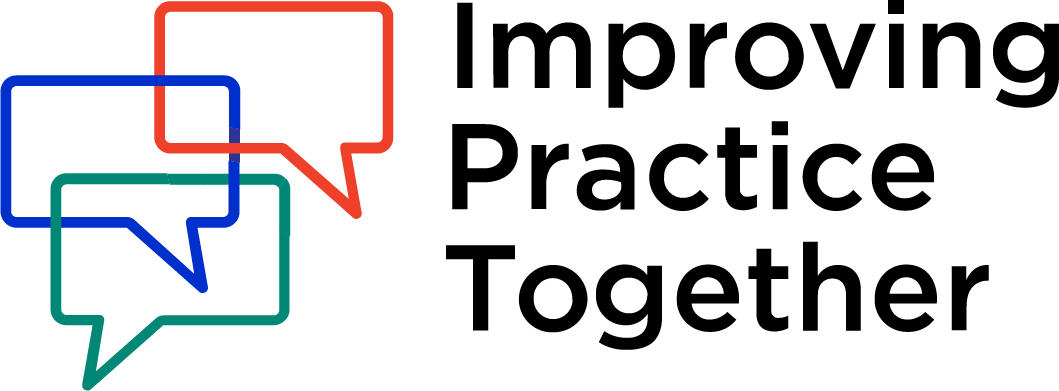Building a Community of Practice
Teacher leaders contribute to the process of developing professional learning experiences for themselves and their colleagues.
The Improving Practice Together project and approach rely on the foundation of a high capacity partnership that includes a school district with a dedicated science leader and an external professional learning partner (or internal dedicated science team). Using IPT resources to build a community of practice may require similar robust capacity.
The goal for the teacher leaders is to 1) become more reflective in their own practice in order to develop their capacity to support their students to engage in argument from evidence as a sense-making tool for science learning, and 2) to be able to lead professional learning experiences to support their colleagues in achieving that same goal. To address this second goal, teacher leaders need to feel that they are in an environment where they can share their fears and vulnerabilities, feel supported and respected by the instructors and their colleagues, and inspired to push themselves out of their comfort zones in order to grow professionally.
The teacher leadership component therefore includes, Building a community of practice. Each session with the teacher leaders includes some sort of team builder, communication exercise, or adult Social Emotional Learning protocol to help teachers develop trust, respect and a collaborative mindset for the work. It is also helpful to begin the process with the development of a shared set of group or community agreements for how all involved in the professional learning experience will interact with each other. Here is a list of resources to draw from:
Resources
Reflecting on Practice Community Agreements: Community or Group Agreements represent a consensus on what all members of a community or working group need from each other in order to feel seen, heard and valued, and to be able to efficiently get work done together. The Reflecting on Practice project at the Lawrence Hall of Science developed this set of Community Agreements and tested them in many different contexts.
National School Reform Faculty: The NSRF provides collaboration protocols to promote meaningful, efficient communication, problem solving, and learning. Teacher leaders learn to use the protocols to improve their collaborative work with each other and the effectiveness of their work with other teachers. The protocols used in the IPT teacher leadership institute included Comfort Zones, Probing Questions Exercise, Consultancy.
The NSRF has a vast array of protocols and activities to help participants:
- Address complex dilemmas with fresh perspectives
- Facilitate problem solving with probing questions
- Share and learn from successes
- Introduce ideas, topics, or programs
- Expand thinking, find essential messages, discover other perspectives
- Interpret data
- Observe classrooms and environments to improve teaching, coaching, learning
- Brainstorm and improve projects, plans, or materials at any stage of progress
- Look at student work with specific objectives and needs in mind to improve outcomes
National School Reform Faculty: The NSRF provides protocols to promote meaningful, efficient communication, problem solving, and learning. These protocols give time for active listening and reflection, and ensure that all voices in the group are heard and honored. Teacher leaders learn to use the protocols appropriately to build the skills and the culture necessary for productive collaborative work. The protocols used in the teacher leadership institute included Comfort Zones, Probing Questions, Consultancy.
The NSRF has a vast array of protocols and activities to help participants:
- Address complex dilemmas with fresh perspectives
- Improve their work quickly with thought-provoking questions
- Share and learn from successes
- Introduce ideas, topics, or programs
- Expand thinking, find essential messages, discover other perspectives
- Interpret data
- Observe classrooms and environments to improve teaching, coaching, learning, or other work
- Brainstorm and improve projects, plans, or materials at any stage of progress
- Look at student work with specific objectives and needs in mind to improve outcomes
CASEL (Collaborative for Academic, Social, and Emotional Learning) District Resource Center:
The CASEL core competencies for social emotional learning support students to engage in argumentation-focused discussions in science and other subjects. In the IPT teacher leadership institute, teacher leaders discussed each competency to explore their own understanding, how they teach that competency, and how it relates to developing a culture of talk in the classroom. They examined how to systematically incorporate SEL when establishing a culture of talk and when facilitating other teachers.
CASEL identifies five core competencies that help children and adults navigate the world more effectively.
- Self-awareness
- Self-management
- Social awareness
- Relationship skills
- Responsible decision-making
Here is an explanation of each competency.
Cognitive Capital: Investing in Teacher Quality: IPT Teacher leaders read and discussed excerpts (pp.20-29) from this book written by Arthur L. Costa, Robert J. Garmston, Diane P. Zimmerman, to reflect on their own leadership capabilities within their district system. In the authors’ declaration of teacher quality teacher leaders were asked to focus on the following passage:
“1. Schools are communities composed of many talented, unique individuals. Individual teachers, while they have their own identity and pedagogical beliefs, are also members of a larger culture and community of educators. This duality between self and community often produces polarities.
2. Recognizing these polarities, informed leaders foster not only individual but also collective efficacy, consciousness, flexibility, craftsmanship, and interdependence. They strive to develop self-directed professionals with the cognitive capacity for high performance both independently and as members of a community.”
Teacher leaders discussed and probed their own levels of efficacy, consciousness, flexibility, craftsmanship, and interdependence.

